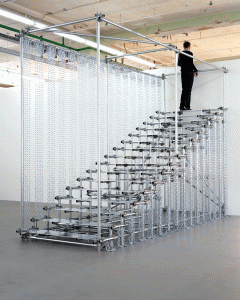« Reviews
Monica Bonvicini: Bet Your Sweet Life

Monica Bonvicini, Scale of Things (to come), 2010, © Monica Bonvicini @ VG BildKunst. Courtesy Galerie Max Hetzler, Berlin
Galerie Max Hetzler - Berlin
By Helmut Schuster
What began in the year 2007 as a temporary location for the Galerie Max Hetzler in Berlin (originally in Stuttgart and Cologne) is now the major gallery’s sole, central exhibition location. In Berlin, where the crisis in the art market has been successfully resisted by the establishment of new art centres, as in Heidestrasse, Potsdamerstrasse and the area around Checkpoint Charlie, the move to the solitude of the Osramhöfe in the district of Wedding is rather surprising and may not have been completely voluntary. It is here, then, that Monica Bonvicini, the gallery’s new supernova, is staging her exhibition “Bet Your Sweet Life” on approximately 1,000 square metres.
If one actively follows the career of the artist, who was born in Venice in 1965 and has been active for many years now, one can identify a thread running right through her work. Bonvicini grapples with interface between architecture and sexuality. In her work, she repeatedly and critically tackles the question of male power and men’s role in modernistic concepts of urban order and planning.
In this respect, Bonvicini is a child of her time. She grew up in late-Fascist Italy, where Catholic and male power figures were dominant within society and the family. There, as in Germany, many of the former, mainly male, perpetrators regained their former positions and authority. In her youth, Bonvicini experienced a second phase of de-democratisation and followed the rise of media mogul Silvio Berlusconi, who - as is well known - still shapes the values of Italian society to this day. Her studies in Berlin and California, two regions superficially overloaded with myths of freedom, compelled her to confront herself in reality with phallocentric structures.
Bonvicini responded to these heteronymous social structures - which influence her, too - with the means of art. She created key works such as Wallfuckin (1995) and Pavilion (2002). At the time, the women’s movement in Europe was essential and the gender discussion was at its height. Bonvicini was spot on, and her artistic activities were one of the stepping stones necessary for taking small steps towards achieving the changes that would make a new conception of gender roles possible in the first place.
Now, in 2010, the United States has its first African-American president, and Angela Merkel is the German chancellor. The world has been pillaged by corrupt economic systems, and the issues of migration, inequality and environmental destruction are becoming increasingly important. Now, in 2010, women must ask themselves whether Monica Bonvicini’s seemingly provocative, critical attitude still gets to the crux of the matter, or whether she is simply reproducing only herself and delivering stereotypes in order to fulfill expectations on the global art market.
Scale of Things, an interactive staircase leading nowhere, is certainly well crafted; ultimately, however, it is merely a replica of her work Stairway to Hell (2003), which was definitely relevant at the time - especially at the 8th Istanbul Biennial (2003). It shows how critical debate has degenerated into slick salon art.
Black you, an installation comprising a bed, a chair and a table covered with leather, repeatedly cites the role image of a woman, who is half whore and half domestic, at the stove. Here, the significance of leather as a fetish material is overstated to the point of banality.
Of all her works, the video No Head Man (2009) speaks in the most direct language. In the end, the men bash their heads against a wall. That is about as near as the entire exhibition gets to making a statement.
Nevertheless, the series of large-size tempera and spray paint drawings is genuinely moving. The works entitled Hurricane and Other Catastrophes are masterfully drawn, and moving in their simplicity.
Success is a blessing and creates new potential, as Monica Bonvicini proves in her work She Lies, which is situated in front of the Oslo Opera House. This makes the current exhibition at Max Hetzler all the more dispensable. Occasionally, plus and plus produce only minus.
(April 30 - June 5, 2010)
Helmut Schuster is a psychologist and art historian. He is an independent curator and director of Galerie Schuster in Berlin and Miami.
Filed Under: Reviews


































